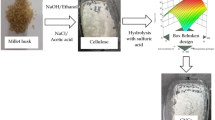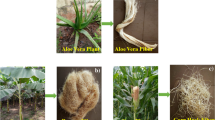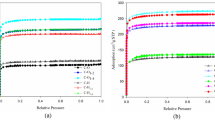Abstract
The present study deals with chemical characterization and pyrolysis kinetics of Dalbergia sissoo wood (DSW). The characterization of DSW, in terms of proximate, ultimate, biochemical compositions, and TG-FTIR analysis are carried out. FTIR, coupled with TG system, identified the traces of various volatiles such as H2O, CH4, CO2, CO, CH3CHO, HCHO, CH3COCH3, CH3COOH, HCOOH, and R–OH during pyrolysis. Further, a non-isothermal TG for the pyrolysis of DSW has been performed in a nitrogen atmosphere. The integral isoconversional model-free methods are applied on TG data of DSW to evaluate activation energies at five different heating rates from 5 to 30 °C min−1. The variations in pyrolysis behavior as reflected by the activation energies have been explained based on type of volatiles that gets released with time during the degradation process. The full range of solid-state kinetic models purposed by Malek method produced best fits with TG results, with the 3-D diffusion model followed by random nucleation with three nuclei on the individual particle.







Similar content being viewed by others
Abbreviations
- α :
-
Conversion or reaction progress
- β :
-
Heating rate/°C min−1
- \(E_{\text{a}}\) :
-
Apparent activation energy/kJ mol−1
- \(E_{\upalpha}\) :
-
Activation energy at conversion α/kJ mol−1
- A :
-
Pre-exponential factor/min−1
- K :
-
Reaction rate constant/min−1
- n :
-
Order of reaction
- R :
-
Universal gas constant (8.314 kJ kmol−1 K−1)
- T :
-
Temperature/K
- p(x):
-
Exponential/temperature integral approximation
- f(α):
-
Differential form of reaction model
- g(α):
-
Integral form of reaction model
- \(T_{\text{m}}\) :
-
Temperature at maximum peak in DTG curve/K
- \(T_{\text{i}}\) :
-
Initial temperature of the active pyrolysis zone/K
- \(T_{\text{f}}\) :
-
Final temperature of the passive pyrolysis zone/K
- \(R^{2}\) :
-
Correlation coefficient
- rE:
-
Relative error
- DSW:
-
Dalbergia sissoo wood
- TG:
-
Thermogravimetric analysis/thermogravimetry
- DTG:
-
Differential thermogravimetric analysis
- FTIR:
-
Fourier-transformed infrared spectroscopy
- TG-FTIR:
-
The thermogravimetry coupled with Fourier-transformed infrared spectroscopy
- OFW:
-
Ozawa–Flynn–Wall
- DAEM:
-
Distributed activation energy model
- V.AIC:
-
Advanced isoconversional method of Vyazovkin
- NL:
-
Nonlinear
- HHV:
-
High heating value
- LHV:
-
Low heating value
- HCE:
-
Hemicellulose
- CELL:
-
Cellulose
- LIG:
-
Lignin
- OBM:
-
Order-based model
References
Ghosh SK. Potential of economic utilization of biomass waste in India: Implications towards SDGs. Seventh Reg 3R Forum Asia Pacific. 2016.
Demirbaş A, Arin G. An overview of biomass pyrolysis. Energy Sour. 2002;24:471–82.
Khawam A, Flanagan DR. Complementary use of model-free and modelistic methods in the analysis of solid-state kinetics. J Phys Chem B. 2005;109:10073–80.
Vyazovkin S, Wight CA. Isothermal and non-isothermal kinetics of thermally stimulated reactions of solids. Int Rev Phys Chem. 1998;17:407–33.
Starink MJ. A new method for the derivation of activation energies from experiments performed at constant heating rate. Thermochim Acta. 1996;288:97–104.
Kissinger HE. Reaction kinetics in differential thermal analysis. Anal Chem. 1957;29:1702–6.
Ruitenberg G, Woldt E, Petford-Long AK. Comparing the Johnson–Mehl–Avrami–Kolmogorov equations for isothermal and linear heating conditions. Thermochim Acta. 2001;378:97–105.
Vyazovkin S, Wight CA. Model-free and model-fitting approaches to kinetic analysis of isothermal and nonisothermal data. Thermochem Acta. 1999;340–341:53–68.
Mansaray KG, Ghaly AE. Determination of kinetic parameters of rice husks in oxygen using thermogravimetric analysis. Biomass Bioenergy. 1999;17:19–31.
Vyazovkin S, Burnham AK, Criado JM, Pérez-Maqueda LA, Popescu C, Sbirrazzuoli N. ICTAC kinetics committee recommendations for performing kinetic computations on thermal analysis data. Thermochim Acta. 2011. https://doi.org/10.1016/j.tca.2011.03.034.
Sbirrazzuoli N. Is the Friedman method applicable to transformations with temperature dependent reaction heat? Macromol Chem Phys. 2007;208:1592–7.
Yunqing H. Theoretical study of thermal analysis kinetics. 2014.
Manyà JJ, Velo E, Puigjaner L. Kinetics of biomass pyrolysis: a reformulated three-parallel-reactions model. Ind Eng Chem Res. 2003;42:434–41.
Wang X, Hu M, Hu W, Chen Z, Liu S, Hu Z, et al. Thermogravimetric kinetic study of agricultural residue biomass pyrolysis based on combined kinetics. Bioresour Technol. 2016;219:510–20. https://doi.org/10.1016/j.biortech.2016.07.136.
Weerachanchai P, Tangsathitkulchai C, Tansathitkulchai M. Comparison of pyrolysis kinetic models for thermogravimetric analysis of biomass. Suranaree J Sci Technol. 2010;17:387–400.
Poletto M, Zattera AJ, Santana RMC. Thermal decomposition of wood: kinetics and degradation mechanisms. Bioresour Technol. 2012;126:7–12.
Criado JM, Málek J, Ortega A. Applicability of the master plots in kinetic analysis of non-isothermal data. Thermochim Acta. 1989;147:377–85.
Núñez L, Fraga F, Núñez MR, Villanueva M. Thermogravimetric study of the decomposition process of the system BADGE (n = 0)/1,2 DCH. Polymer (Guildf). 2000;41:4635–41.
Sánchez-Jiménez PE, Pérez-Maqueda LA, Perejón A, Criado JM. A new model for the kinetic analysis of thermal degradation of polymers driven by random scission. Polym Degrad Stab. 2010;95:733–9.
Bianchi O, Castel CD, De Oliveira RVB, Bertuoli PT, Hillig E. Avaliação da degradação não- isotérmica de madeira através de termogravimetria-TGA. Polimeros. 2010;20:395–400.
Hu Y, Wang Z, Cheng X, Ma C. Non-isothermal TGA study on the combustion reaction kinetics and mechanism of low-rank coal char. RSC Adv R S Chem. 2018;8:22909–16.
Mishra G, Kumar J, Bhaskar T. Kinetic studies on the pyrolysis of pinewood. Bioresour Technol. 2015;182:282–8. https://doi.org/10.1016/j.biortech.2015.01.087.
Souza BS, Moreira APD, Teixeira AMRF. TG-FTIR coupling to monitor the pyrolysis products from agricultural residues. J Therm Anal Calorim. 2009;97:637–42.
Kumar M, Kumar M, Arora S. Thermal degradation and flammability studies of wood coated with fly ash intumescent composites. J Indian Acad Wood Sci. 2013;10:125–33.
Ranzi E, Cuoci A, Faravelli T, Frassoldati A, Migliavacca G, Pierucci S, et al. Chemical kinetics of biomass pyrolysis. Energy Fuels. 2008;22:4292–300.
Anca-Couce A, Scharler R. Modelling heat of reaction in biomass pyrolysis with detailed reaction schemes. Fuel. 2017;206:572–9.
Sebio-Puñal T, Naya S, López-Beceiro J, Tarrío-Saavedra J, Artiaga R. Thermogravimetric analysis of wood, holocellulose, and lignin from five wood species. J Therm Anal Calorim. 2012;109:1163–7.
Yang H, Yan R, Chen H, Lee DH, Zheng C. Characteristics of hemicellulose, cellulose and lignin pyrolysis. Fuel. 2007;86:1781–8.
Mishra RK, Mohanty K. Pyrolysis kinetics and thermal behavior of waste sawdust biomass using thermogravimetric analysis. Bioresour Technol. 2018;251:63–74. https://doi.org/10.1016/j.biortech.2017.12.029.
Slopiecka K, Bartocci P, Fantozzi F. Thermogravimetric analysis and kinetic study of poplar wood pyrolysis. Appl Energy. 2012;97:491–7. https://doi.org/10.1016/j.apenergy.2011.12.056.
Chen Z, Zhu Q, Wang X, Xiao B, Liu S. Pyrolysis behaviors and kinetic studies on Eucalyptus residues using thermogravimetric analysis. Energy Convers Manag. 2015;105:251–9. https://doi.org/10.1016/j.enconman.2015.07.077.
Ghodke P, Mandapati RN. Investigation of particle level kinetic modeling for babul wood pyrolysis. Fuel. 2019;236:1008–17. https://doi.org/10.1016/j.fuel.2018.09.084.
Meng H, Wang S, Chen L, Wu Z, Zhao J. Thermal behavior and the evolution of char structure during co-pyrolysis of platanus wood blends with different rank coals from northern China. Fuel. 2015;158:602–11. https://doi.org/10.1016/j.fuel.2015.06.023.
Salehi E, Abedi J, Harding T. Bio-oil from sawdust: pyrolysis of sawdust in a fixed-bed system. Energy Fuels. 2009;23:3767–72.
Özbay G. Catalytic pyrolysis of pine wood sawdust to produce bio-oil: effect of temperature and catalyst additives. J Wood Chem Technol. 2015;35:302–13.
Soria-Verdugo A, Goos E, García-Hernando N. Effect of the number of TGA curves employed on the biomass pyrolysis kinetics results obtained using the Distributed Activation Energy Model. Fuel Process Technol. 2015;134:360–71. https://doi.org/10.1016/j.fuproc.2015.02.018.
Bianchi O, Martins JDN, Fiorio R, Oliveira RVB, Canto LB. Changes in activation energy and kinetic mechanism during EVA crosslinking. Polym Test. 2011;30:616–24. https://doi.org/10.1016/j.polymertesting.2011.05.001.
Burnham AK, Dinh LN. A comparison of isoconversional and model-fitting approaches to kinetic parameter estimation and application predictions. J Therm Anal Calorim. 2007;89:479–90.
Doyle CD. Series approximations to the equation of thermodynamic data. Nature. 1965;207:290–1.
Pérez-Maqueda LA, Sánchez-Jiménez PE, Criado JM. Kinetic analysis of solid-state reactions: precision of the activation energy calculated by integral methods. Int J Chem Kinet. 2005;37:658–66.
Starink MJ. The determination of activation energy from linear heating rate experiments: a comparison of the accuracy of isoconversion methods. Thermochim Acta. 2003;404:163–76.
Coats AW, Redfern JP. Kinetic parameters from thermogravimetric data. Nature. 1964;201:68–9.
Senum GI, Yang RT. Rational approximations of the integral of the Arrhenius function. J Therm Anal. 1977;11:445–7.
Flynn JH, Wall LA. General trement of the therogravimetry of polymers. J Res Natl Bur Stand. 1934;1966(70A):487–523.
Takeo O. A new method of analyzing thermogravimetric data. Bull Chem Soc Jpn. 1965;38:1881–6. https://doi.org/10.1246/bcsj.38.1881.
Li J, Zhang C, Yin R, Zhang W. Thermal debinding behavior of a low-toxic DMAA polymer for gelcast ceramic parts based on TG- FTIR and kinetic modeling. RSC Adv R Soc Chem. 2019;9:8415–25.
Miura K, Maki T. A simple method for estimating f(E) and ko(E) in the distributed activation energy model. Energy & Fuels. 1998;12:864–9.
Ortega A. A simple and precise linear integral method for isoconversional data. Thermochim Acta. 2008;474:81–6.
Vyazovkin S. Modification of the integral isoconversional method to account for variation in the activation energy. J Comput Chem. 2001;22:178–83.
Vyazovkin S. Model-free kinetics staying free of multiplying entities without necessity. J Therm Anal Calorim. 2006;83:45–51.
Khawam A, Flanagan DR. Solid-state kinetic models: basics and mathematical fundamentals. J Phys Chem B. 2006;110:17315–28.
Shuping Z, Yulong W, Mingde Y, Chun L, Junmao T. Pyrolysis characteristics and kinetics of the marine microalgae Dunaliella tertiolecta using thermogravimetric analyzer. Bioresour Technol. 2010;101:359–65. https://doi.org/10.1016/j.biortech.2009.08.020.
Basu P. Biomass gasification and pyrolysis, practical design and theory. Amsterdam: Elsevier; 2010.
Channiwala SA, Parikh PP. A unified correlation for estimating HHV of solid, liquid and gaseous fuels. Fuel. 2002;81:1051–63.
Parmar K. Biomass: an overview on composition characteristics and properties. IRA-Int J Appl Sci. 2017;7:42.
Salaheldeen M, Aroua MK, Mariod AA, Cheng SF, Abdelrahman MA. An evaluation of Moringa peregrina seeds as a source for bio-fuel. Ind Crops Prod. 2014;61:49–61. https://doi.org/10.1016/j.indcrop.2014.06.027.
Li S, Xu S, Liu S, Yang C, Lu Q. Fast pyrolysis of biomass in free-fall reactor for hydrogen-rich gas. Fuel Process Technol. 2004;85:1201–11.
El-Sayed SA, Mostafa ME. Kinetic parameters determination of biomass pyrolysis fuels using TGA and DTA techniques. Waste Biomass Valorization. 2015;6:401–15.
Cagnon B, Py X, Guillot A, Stoeckli F, Chambat G. Contributions of hemicellulose, cellulose and lignin to the mass and the porous properties of chars and steam activated carbons from various lignocellulosic precursors. Bioresour Technol. 2009;100:292–8.
Rueda-Ordóñez YJ, Tannous K. Isoconversional kinetic study of the thermal decomposition of sugarcane straw for thermal conversion processes. Bioresour Technol. 2015;196:136–44.
Zhang X, Yang W, Blasiak W. Modeling study of woody biomass : interactions of cellulose, hemicellulose, and lignin. Energy & Fuels. 2011;25:4786–95.
Werner K, Pommer L, Broström M. Thermal decomposition of hemicelluloses. J Anal Appl Pyrolysis. 2014;110:1–8. https://doi.org/10.1016/j.jaap.2014.08.013.
Cao H, Xin Y, Wang D, Yuan Q. Pyrolysis characteristics of cattle manures using a discrete distributed activation energy model. Bioresour Technol. 2014;172:219–25. https://doi.org/10.1016/j.biortech.2014.09.049.
Mallick D, Poddar MK, Mahanta P, Moholkar VS. Discernment of synergism in pyrolysis of biomass blends using thermogravimetric analysis. Bioresour Technol. 2018;261:294–305. https://doi.org/10.1016/j.biortech.2018.04.011.
Acknowledgements
The current research work is supported by Ministry of Human Resource and Development (M.H.R.D), Government of India, New Delhi, for providing the financial aid to carry out this research at Indian Institute of Technology Roorkee, Roorkee, India.
Author information
Authors and Affiliations
Corresponding author
Additional information
Publisher's Note
Springer Nature remains neutral with regard to jurisdictional claims in published maps and institutional affiliations.
Rights and permissions
About this article
Cite this article
Sharma, A., Mohanty, B. Non-isothermal TG/DTG-FTIR kinetic study for devolatilization of Dalbergia sissoo wood under nitrogen atmosphere. J Therm Anal Calorim 146, 865–879 (2021). https://doi.org/10.1007/s10973-020-09978-0
Received:
Accepted:
Published:
Issue Date:
DOI: https://doi.org/10.1007/s10973-020-09978-0




